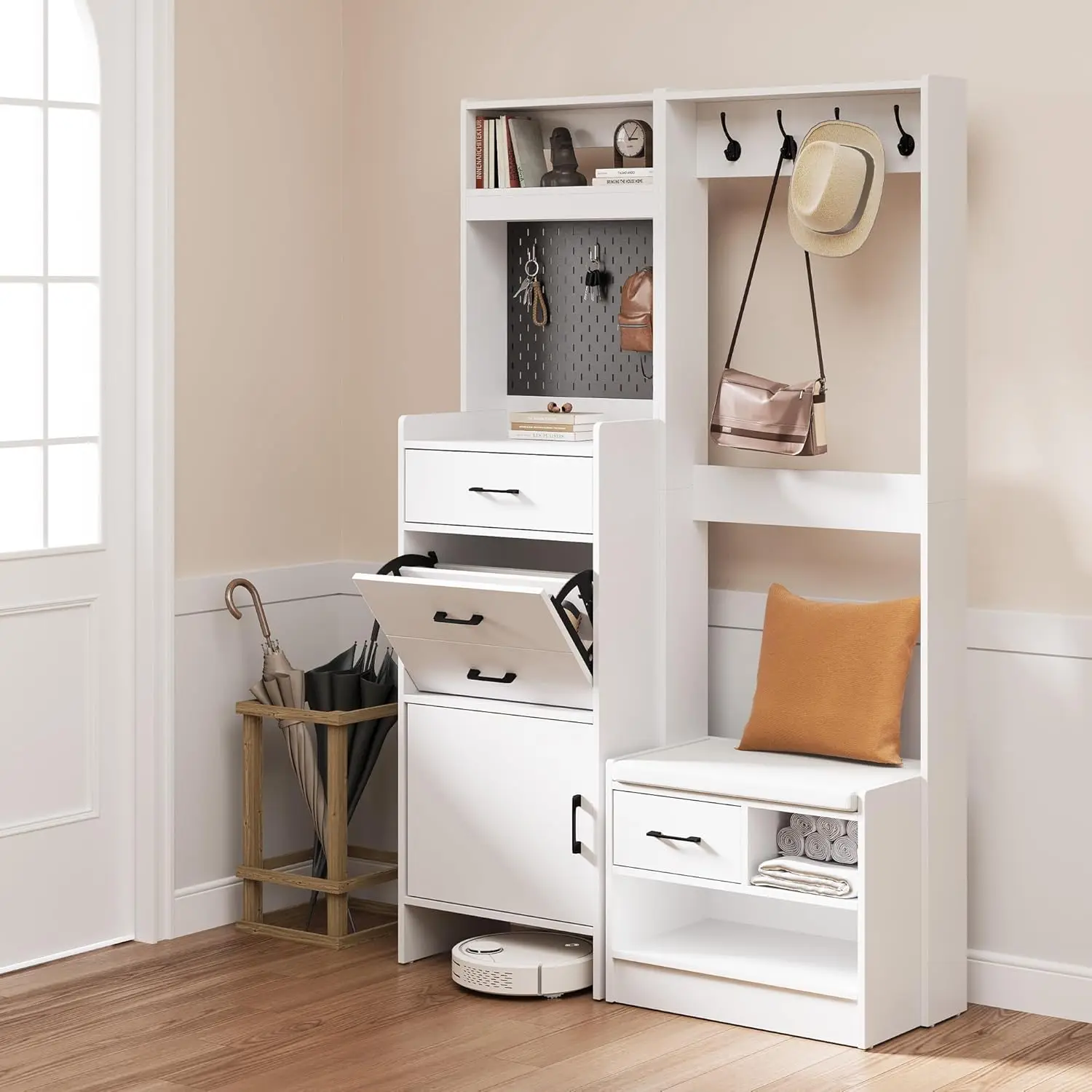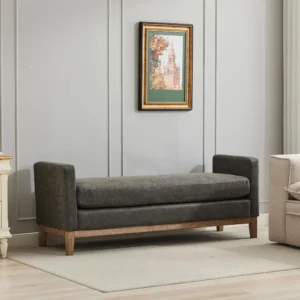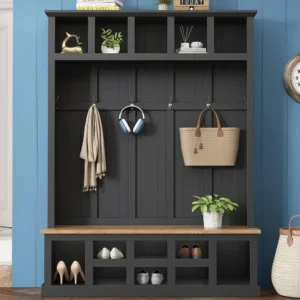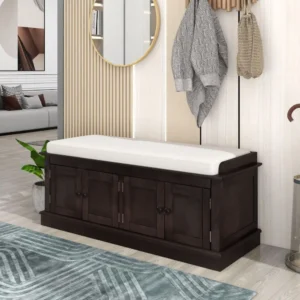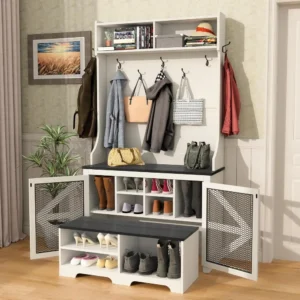Introduction
Creating a functional mudroom is all about managing the chaos that comes with daily comings and goings. This transition space between the outdoors and your home’s interior serves as the first line of defense against clutter from outdoor activities. However, many homeowners struggle with common mudroom challenges:
- Limited square footage (the average mudroom is just 12-15 square feet)
- Difficulty organizing seasonal items, shoes, bags, and outerwear
- Finding solutions that are both practical and visually appealing
- Creating designated spaces for family members in shared areas
Multi-functional seating represents an efficient solution to these challenges by addressing multiple needs simultaneously. Rather than having separate furniture pieces for sitting and storage, these dual-purpose solutions provide a comfortable spot to put on and remove shoes while maximizing storage capacity.
The average person spends nearly 10 minutes daily searching for items in cluttered spaces—time that could be saved with proper organization systems. By transforming entryway space-saving benches into organizational powerhouses, you can create a mudroom that works for your family’s specific needs.
In this guide, we’ll explore various seating options, essential features to consider, design approaches, and how to select the perfect solution for your space.
Why Multi-Functional Mudroom Seating Is Essential
Space Optimization
Multi-functional seating makes the most of both vertical and horizontal space. Instead of dedicating separate areas for a bench and storage units, these pieces combine functions into a single footprint. This approach can save up to 30% of floor space compared to separate furniture pieces, making them ideal for smaller homes.
Organization Benefits
Well-designed mudroom seating creates designated storage compartments that reduce daily clutter. With specific places for shoes, bags, sports equipment, and seasonal items, you’ll eliminate the “drop zone” effect where items accumulate on floors and surfaces.
Functional Advantages
The dual purpose of these pieces cannot be overstated—they provide comfortable seating during shoe changes while storing seasonal items underneath or alongside. This functionality is particularly valuable during busy morning routines when family members need to prepare for the day simultaneously.
Convenience Factor
Having essentials stored where they’re needed most reduces morning stress and time spent searching for items. When everything has a designated place near the entry point, family members are more likely to maintain organizational systems.
Design Impact
Beyond pure functionality, well-designed mudroom benches contribute significantly to home aesthetics. These pieces serve as focal points that set the tone for your home’s interior and make a positive first impression on guests.
Home organization studies consistently show that well-organized entry spaces reduce stress levels and create a sense of calm when entering the home. By investing in quality multi-functional seating, you’re not just buying furniture—you’re enhancing your daily living experience.
Types of Multi-Functional Seating for Mudrooms
Storage Benches
Storage benches form the foundation of mudroom seating options, with several variations to consider:
Lift-top Storage Benches
* Perfect for storing bulky seasonal items like winter gear and sports equipment
* Provides concealed storage that keeps visual clutter at bay
* Typically offers the largest storage capacity (10-15 cubic feet)
* Ideal for items used less frequently
Cubby Benches
* Features open compartments for easy access to daily essentials
* Promotes better air circulation for wet shoes and boots
* Often accommodates storage baskets for smaller items
* Typically holds 4-8 pairs of adult shoes per cubby
Drawer Benches
* Offers organized storage for smaller items like gloves, scarves, and pet supplies
* Prevents items from being visible when drawers are closed
* Provides more structured organization than lift-top designs
* Usually features 2-4 drawers depending on bench width
Shoe Storage Benches
* Specifically designed with compartments sized for footwear
* May include angled shelves that display shoes for easy selection
* Keeps shoes off the floor and organized by family member
* High-quality mudroom bench shoe storage can accommodate 8-12 pairs of shoes
Hall Trees with Seating
Hall trees combine vertical storage with seating for a complete entryway solution:
* Incorporate hooks or cubbies above a bench seat
* Maximize vertical wall space while providing seating
* Often feature mirrors for last-minute appearance checks
* Some designs include shoe storage beneath the bench
* Typical dimensions range from 36-72 inches wide and 72-84 inches tall
Built-in Custom Benches
Custom built-ins maximize space efficiency:
* Designed to fit your specific wall dimensions with no wasted space
* Can be designed around obstacles like heating vents or electrical outlets
* Often incorporate multiple storage types (cubbies, drawers, cabinets)
* Create a high-end, integrated look that can increase home value
Floating Benches
Floating designs create visual spaciousness:
* Mount directly to the wall without legs touching the floor
* Create an illusion of more floor space in smaller rooms
* Allow for easy cleaning underneath
* Typically support 250-400 pounds depending on mounting hardware
Understanding the different types of multi-functional mudroom benches will help you determine which solution best fits your specific needs and space constraints.
Key Features to Look for in Mudroom Seating
Storage Capacity Considerations
When evaluating storage capacity, consider:
- Household size needs: Allow approximately 1-2 cubic feet of storage per family member
- Compartment configurations:
- Open cubbies: Best for frequently used items and providing ventilation
- Closed drawers: Ideal for smaller accessories like gloves and scarves
- Lift-top storage: Perfect for seasonal items and bulkier gear
- Adjustability options: Look for movable dividers or modular components that adapt as your needs change
Comfort and Ergonomics
Since your mudroom bench will be used daily:
- Ideal seating height: 17-19 inches (43-48 cm) provides optimal ergonomics for most adults
- Cushioning options:
- Foam density of 2-3 inches offers good support without excessive softness
- Performance fabrics resist stains and moisture
- Removable mudroom bench cushions allow for easy cleaning
- Support features: Look for sturdy construction that prevents sagging even with regular use
Durability Factors
Material quality dramatically affects longevity:
- Material durability ranking (from most to least durable):
- Hardwoods (oak, maple, walnut): Lasts 20+ years with proper care
- Metal frames: Extremely durable but may need wood or upholstered seating surfaces
- Engineered wood: Variable lifespan (10-15 years) depending on quality
- Particleboard: Least durable option, especially in humid environments
- Finish considerations: Look for water-resistant finishes that can withstand dampness from shoes and outerwear
- Moisture resistance: Sealed wood or metal constructions perform best in variable humidity conditions
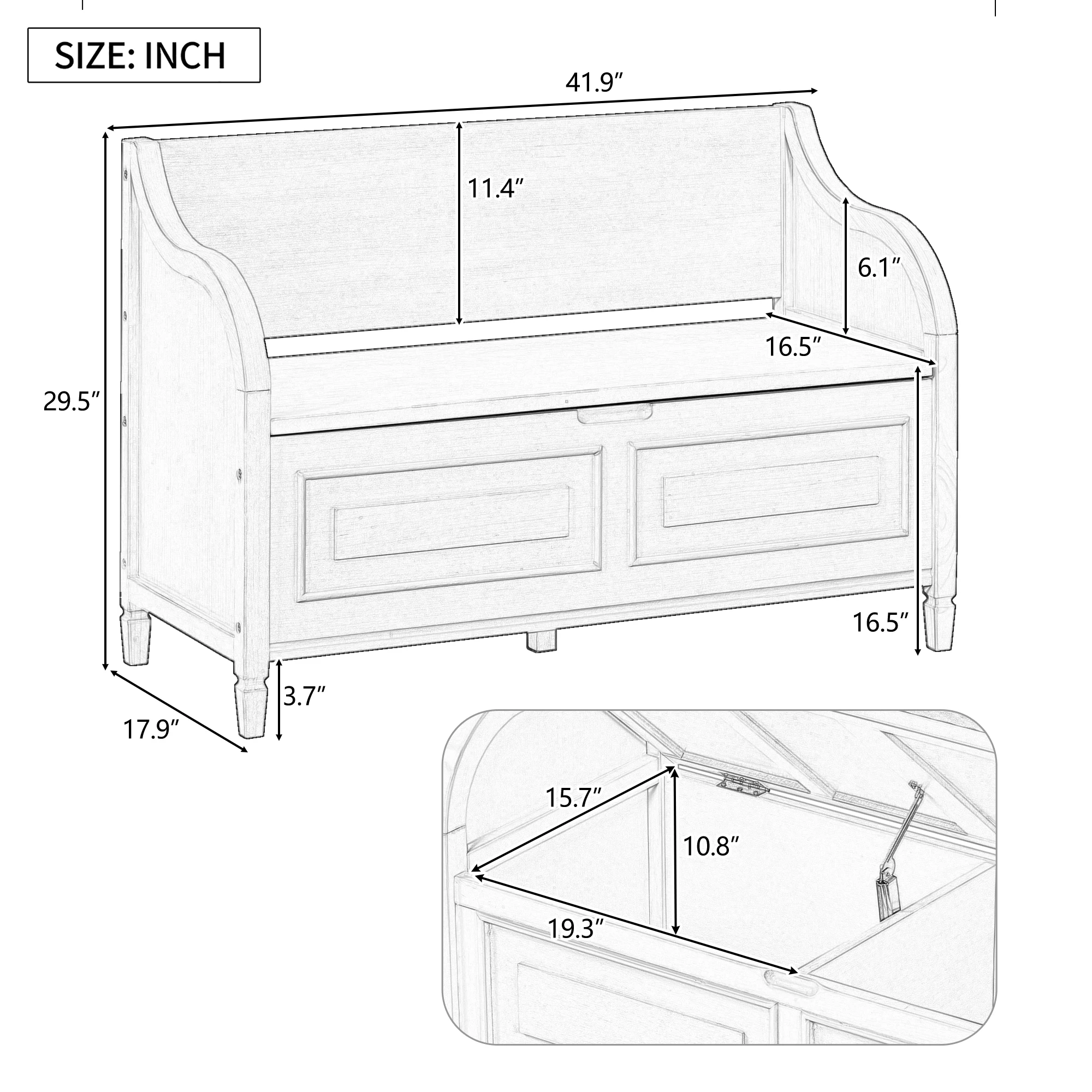
Space Requirements
Before purchasing, consider:
- Proper measurements: Allow 24 inches (61 cm) of bench width per seated person
- Traffic flow clearance: Maintain at least 36 inches (91 cm) of walking space in front of the bench
- Depth requirements: Standard bench depth ranges from 15-18 inches (38-46 cm)
Safety Features
Don’t overlook these important safety elements:
- Soft-close mechanisms: Prevent pinched fingers on drawers and lift-tops
- Stability requirements: Look for anti-tip features, especially for taller hall trees
- Child-safety considerations: Rounded corners and secure hardware prevent injuries
Matching Seating to Your Mudroom Size and Layout
Small Mudroom Solutions
For spaces under 30 square feet:
* Choose space-saving designs under 36 inches (91 cm) wide
* Prioritize vertical storage with wall-mounted hooks above bench seating
* Select floating benches to keep floor space visible, creating the illusion of more room
* Use mirrors to visually expand the space while serving a practical purpose
* Consider corner benches that maximize otherwise unused angles
Medium-Sized Mudroom Approaches
For spaces between 30-60 square feet:
* L-shaped configurations can maximize corner spaces
* Consider island-style benches that allow access from multiple sides
* Implement both open and closed storage options for versatility
* Designate zones for different family members or storage types
Large Mudroom Possibilities
For spaces over 60 square feet:
* Install multiple seating stations for larger families
* Create family-specific organization systems with personalized cubbies and hooks
* Add specialized storage for sporting equipment, pet supplies, or gardening tools
* Consider built-in cabinetry for a high-end, custom look
Unusual Layouts
For challenging spaces:
* Narrow passages benefit from slim profile benches (12-14 inches deep instead of standard 16-18 inches)
* Work around windows by positioning seating below the windowsill
* Address angled walls with custom-built solutions or carefully selected corner pieces
Creating functional mudroom spaces requires careful planning to design functional mudrooms. For particularly tight spaces, consider space-saving entryway seating solutions that make the most of every available inch.
Design Styles for Multi-Functional Mudroom Seating
Farmhouse/Rustic Style Elements
The farmhouse aesthetic combines charm with practicality:
- Natural woods with distressed or weathered finishes
- Open storage with woven baskets for texture and organization
- Bench features like beadboard panels, plank tops, and simple turned legs
- Color palette featuring warm whites, grays, and natural wood tones
- Decorative elements including metal hardware with an aged appearance
Farmhouse mudroom benches bring warmth and character to entryway spaces while maintaining high functionality.
Modern and Minimalist Approaches
For contemporary homes:
* Clean lines with minimal ornamentation
* Hidden storage compartments with push-to-open mechanisms
* Material choices including engineered wood with matte finishes
* Monochromatic or two-tone color schemes
* Space-efficient designs that appear to float or have slim profiles
Traditional Design Elements
Classic styling offers timeless appeal:
* Rich wood tones like cherry, mahogany, or walnut
* Detailed craftsmanship including raised panels and turned legs
* Cushioning with piping details and tailored upholstery
* Hardware in brass or bronze finishes
* Proportions that complement traditional architecture
Industrial-Inspired Options
For an edgier aesthetic:
* Metal and wood combinations that highlight contrast
* Exposed hardware and structural elements
* Durability features like metal mesh or perforated storage compartments
* Utilitarian designs that emphasize function
* Natural or distressed finishes that develop patina over time
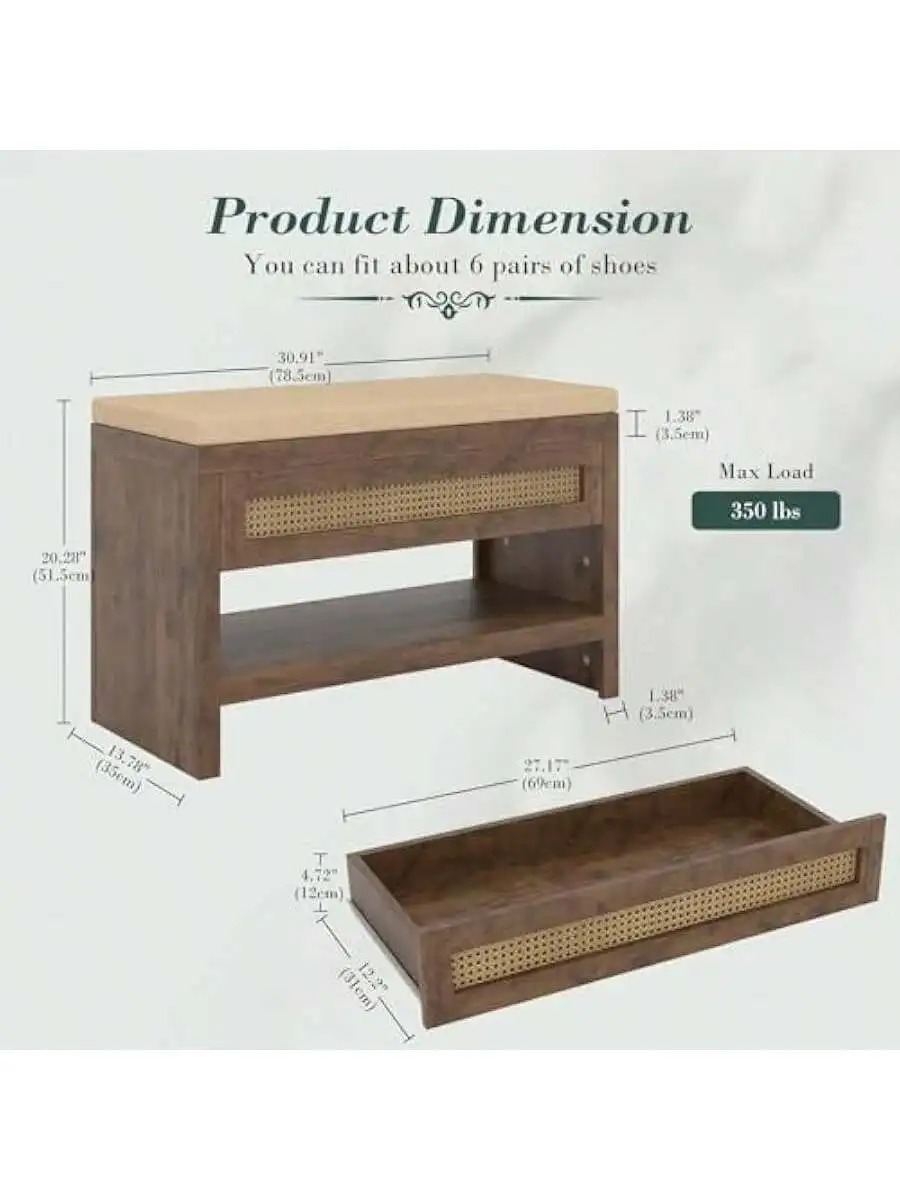
Transitional Solutions
For versatile styling that bridges different aesthetics:
* Simplified traditional forms without excessive detailing
* Neutral color palettes that work with various decorating schemes
* Mix of materials that blend contemporary and classic elements
* Flexible designs that can adapt to evolving home styles
* Understated elegance that complements rather than dominates the space
Built-in vs. Freestanding Options: Making the Right Choice
| Feature | Built-in Seating | Freestanding Pieces |
|---|---|---|
| Installation | Requires carpentry skills or professional help | Ready to use upon delivery |
| Cost | $800-2,500+ depending on materials and size | $150-1,000+ depending on quality |
| Customization | Fully customizable to exact space dimensions | Limited to available manufactured sizes |
| Flexibility | Permanent fixture that stays with home | Can be moved or rearranged as needed |
| Space Efficiency | Maximizes every inch of available space | May leave unusable gaps around edges |
| Timeframe | 1-3 weeks for design and installation | Immediate to 2-week delivery timeframe |
| Property Value | Often increases home resale value | No impact on property value |
Factors to Consider When Deciding
When choosing between built-in and freestanding options:
- Home ownership status: Renters should prioritize freestanding pieces they can take when moving
- Budget constraints: Built-ins require higher initial investment but may offer better long-term value
- Timeline needs: Immediate organization needs favor ready-made solutions
- Space utilization: Unusual dimensions or angles may require custom solutions
- Future flexibility: Consider how your needs might change over the next 5-10 years
For smaller spaces where every inch matters, best small benches for entryways offer compact solutions that don’t sacrifice functionality.
DIY Multi-Functional Seating Projects
Simple DIY Bench with Storage Cubbies
Materials Needed:
* 3/4” plywood or MDF sheets
* 2×4 lumber for frame
* Wood screws and wood glue
* Sanding paper (medium and fine grit)
* Primer and paint or wood stain and polyurethane
* Basic hardware for assembly
Skill Level: Beginner to intermediate
Time Investment: 1 weekend (8-10 hours)
Estimated Cost: $100-150 for materials
Upcycling Existing Furniture
Transform these items into mudroom seating:
* Old dressers (remove top drawers for shoe storage, add cushion to top)
* Kitchen cabinets (place side by side, add a bench top and cushion)
* Bookshelf units (turn horizontally, add dividers and cushion)
* Old headboards (attach to storage cubes for a custom hall tree)
Adding Storage to Existing Benches
Enhance basic benches with:
* Under-seat storage baskets on slides
* Hook rails mounted above the seating area
* Shoe cubbies built beneath an existing bench
* Side attachments for umbrella storage
When to DIY vs. When to Buy
DIY makes sense when:
* You have specific size requirements that standard furniture doesn’t meet
* You enjoy woodworking and have the necessary tools
* You’re working with a limited budget
* You want completely customized organization features
Consider buying pre-made when:
* You need an immediate solution
* You want guaranteed structural integrity for heavy daily use
* You lack the time or tools for quality construction
* The cost difference between materials and a finished product is minimal
Organizing and Accessorizing Your Mudroom Seating
Storage Containers and Baskets
Select containers that enhance functionality:
* Size standardization helps maintain a clean look (measure cubbies before purchasing)
* Durable materials like seagrass, rattan, or canvas withstand daily use
* Removable washable liners extend container life
* Labeling systems help family members maintain organization
* Consider transparent sides for easily identifying contents
Cushions and Comfort Additions
Add comfort with practical materials:
* Weather-resistant fabrics with at least 10,000+ double rubs for durability
* Stain-resistant treatments for easy cleaning
* Attachment methods like ties or non-slip backing prevent shifting
* 2-3 inch foam provides comfort without excessive height
Wall Additions That Complement Bench Storage
Expand functionality with vertical elements:
* Hook systems installed 12-15 inches above seating
* Floating shelves for decorative and functional items
* Key storage solutions near the door for convenience
* Mail organizers to prevent paper clutter
Additional bench hooks and storage systems can dramatically increase the functionality of your mudroom seating area.
Maintaining and Cleaning Multi-Functional Mudroom Seating
Daily and Weekly Maintenance
Establish these simple routines:
* Wipe down seating surfaces daily with a microfiber cloth
* Empty shoe storage weekly to remove debris and dirt
* Reset organization systems at the end of each day
* Check for and address any moisture issues immediately
Material-Specific Care Instructions
Different materials require specific approaches:
* Wood maintenance: Dust regularly and apply furniture polish quarterly
* Metal care: Wipe with damp cloth and dry immediately to prevent rust
* Upholstery cleaning: Vacuum weekly and spot-clean spills immediately
Seasonal Deep Cleaning
Every 3-4 months:
* Empty all storage compartments completely
* Vacuum and wipe down interior storage spaces
* Tighten any loose hardware or connections
* Adjust organization systems for seasonal needs
Extending Furniture Life
Protect your investment with these practices:
* Use boot trays beneath shoe storage during wet seasons
* Apply furniture wax to wood surfaces twice yearly
* Address scratches or damage promptly before they worsen
* Keep direct sunlight off upholstery to prevent fading
Our Top Recommendations for Multi-Functional Mudroom Seating
Best Overall Multi-Functional Seating Options
Look for pieces that combine these key features:
* Generous storage capacity with multiple compartment types
* Durable construction using solid wood or metal frames
* Comfortable seating surface with appropriate height
* Design that complements various home styles
* Dimensions appropriate for average-sized mudrooms (36-48 inches wide)
Top Budget-Friendly Choices
Quality options at lower price points feature:
* Engineered wood construction with quality finishes
* Simplified designs that focus on core functionality
* Standard sizes that fit most spaces
* Basic cushioning that can be upgraded later
* Easy assembly with clear instructions
Most Durable Selections for High-Traffic Homes
For homes with children, pets, and heavy use:
* Metal frame construction with reinforced joints
* Scratch and dent-resistant surfaces
* Water-repellent fabrics and finishes
* Heavier weight (45+ pounds) indicating solid construction
* Warranty coverage of 3+ years
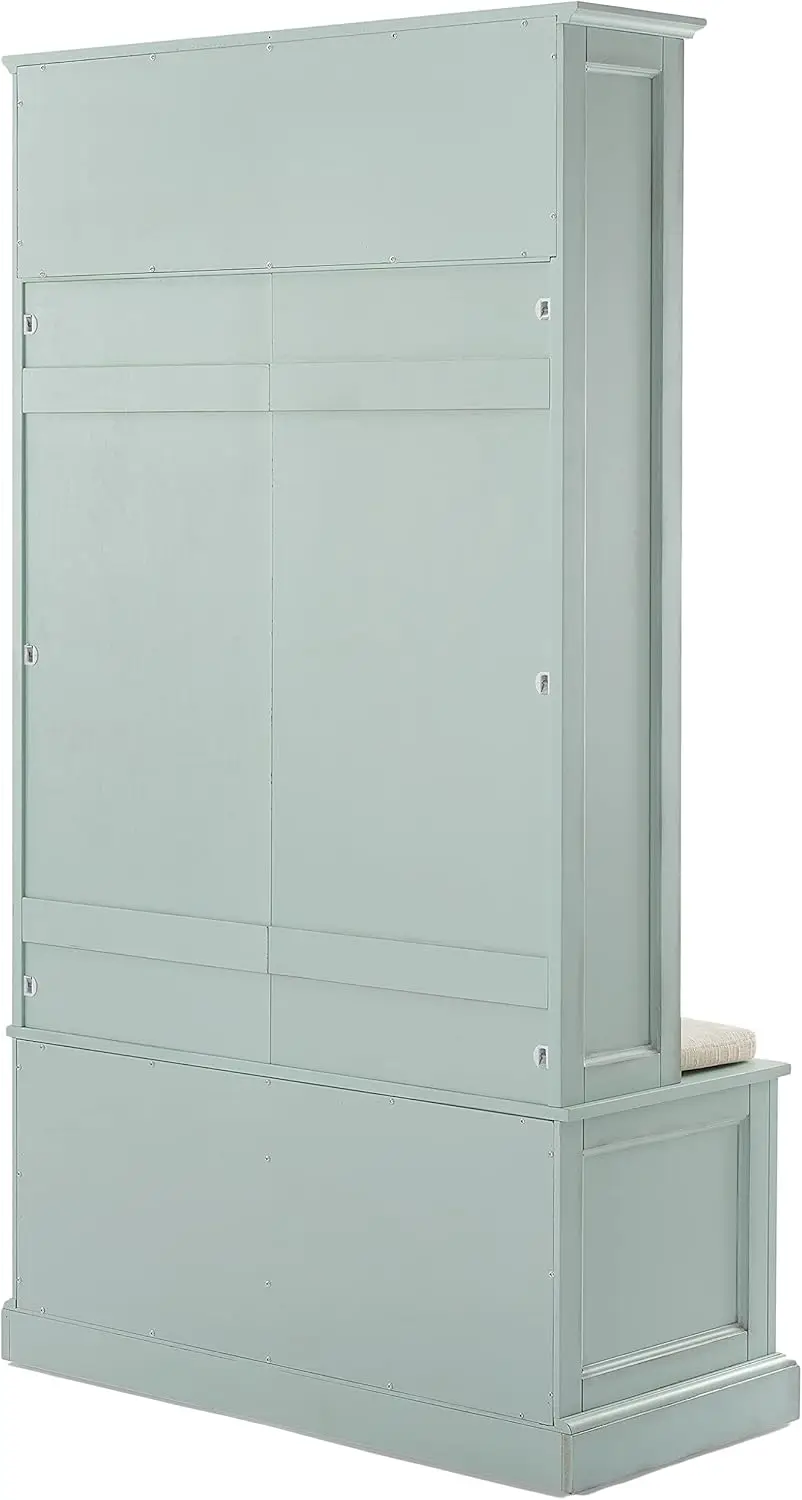
Best Space-Saving Designs
For limited spaces, consider:
* Corner units that utilize otherwise wasted space
* Vertical storage configurations like entryway hall trees
* Slim profiles under 14 inches deep
* Wall-mounted options that free up floor space
* Multi-level storage that maximizes cubic footage
Entryway Bench with Cushion, Mudroom Bench with Cushion, Shoe Bench for Entryway
$1,186.63 Select options This product has multiple variants. The options may be chosen on the product pageBench with Hooks and Storage, Entryway Hall Tree, Mudroom Bench with Cubbies, Mudroom Bench with Shoe Storage
$818.38 Select options This product has multiple variants. The options may be chosen on the product pageModern Entryway Bench, Wood Entryway Bench, Wood Mudroom Bench
$497.69 Select options This product has multiple variants. The options may be chosen on the product pageEntryway Coat Rack Bench, Entryway Hall Tree, Farmhouse Mudroom Bench, Mudroom Bench with Shoe Storage
$805.09 Select options This product has multiple variants. The options may be chosen on the product pageEntryway Bench with Cushion, Mudroom Bench with Cabinets, Shoe Bench for Entryway, Shoe Bench with Cushion
$991.71 Select options This product has multiple variants. The options may be chosen on the product pageBench with Hooks and Storage, Entryway Coat Rack Bench, Entryway Hall Tree, Mudroom Bench with Shoe Storage, Mudroom Coat Rack Bench
$793.73 Select options This product has multiple variants. The options may be chosen on the product page
Most Stylish Options
For design-conscious homes:
* Architectural details that elevate basic forms
* Designer-inspired finishes and hardware
* Thoughtful proportions that create visual balance
* Custom or customizable elements that personalize the piece
* Unexpected material combinations that create visual interest
Frequently Asked Questions About Mudroom Seating
How much seating space per person is ideal for a mudroom bench?
Allow 18-24 inches of width per person for comfortable seating. A family of four would ideally have a bench 72-96 inches long, though this can be divided into multiple seating areas.
What’s the best material for mudroom seating in homes with children and pets?
Solid wood with a polyurethane finish offers the best combination of durability and maintenance. Metal frames with wood seating are also excellent for high-activity households.
Can multi-functional seating work in a very small entryway?
Yes! Look for narrow-depth options (12-14 inches deep instead of standard 16-18 inches) and consider wall-mounted designs that don’t require floor space for legs.
How do I prevent shoes from creating odors in enclosed storage benches?
Choose designs with ventilation holes, use cedar blocks or activated charcoal odor absorbers, and consider leaving the storage area open periodically to air out.
What’s the ideal height for comfortable mudroom seating?
17-19 inches from the floor to the seating surface provides the most comfortable height for most adults. For children, consider a secondary smaller bench or a step stool.
Should mudroom seating have cushions, and if so, what kind?
Cushions add comfort but should be made of durable, stain-resistant fabrics with high-density foam that won’t compress quickly. Removable, washable covers are ideal for mudroom environments.
Transforming Your Entryway: Beyond Basic Seating
Your mudroom seating can become the centerpiece of a comprehensive organization system that transforms how your family enters and exits your home. Consider these expansions:
Create designated zones around your seating area for different family activities—sports equipment in one section, pet supplies in another, and school items in a third. This zoning approach helps maintain organization even during busy times.
Seasonal adaptation strategies allow your mudroom to transition smoothly throughout the year. Consider modular storage components that can be reconfigured as bulky winter coats give way to summer sports equipment.
Technology integration is increasingly important in modern homes. Adding a charging station near your mudroom seating creates a place for devices to rest while you do, keeping electronics organized and charged.
The mudroom sets the tone for your entire home, so consider how your seating contributes to your overall design statement. Even purely functional pieces can incorporate elements that reflect your home’s aesthetic, creating a cohesive look from the moment you step inside.
At Nested Goods, we believe that beautiful organization solutions transform daily routines into moments of satisfaction rather than stress. The right multi-functional seating creates an entryway that welcomes you home while keeping chaos at bay—truly where function meets style.

